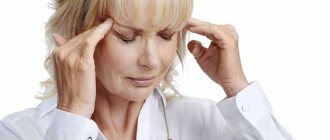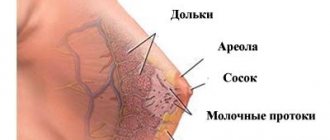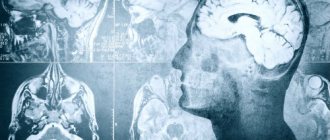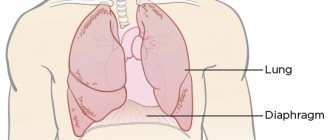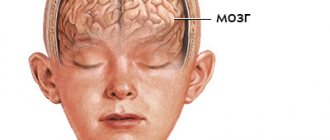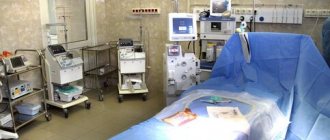What is the clinical picture
There are no specific symptoms of narrowed blood vessels in the brain, with the exception of acutely developing pathologies, such as stroke. Chronic spasm and symptoms of contraction develop gradually. Some chronic diseases (encephalopathy) develop from 2 to 10 years. However, any pathological narrowing can be recognized in the early stages of development using the following symptoms:
- General cerebral signs: headache, dizziness, fatigue from simple work, irritability, sleep disturbance, increased sensitivity to light, sound or smell, drowsiness, lack of desire to engage in work.
- Autonomic disorders: sweating, constipation, diarrhea, paresthesia, shortness of breath, palpitations, decreased appetite, pain in the right hypochondrium, difficulty urinating, erectile dysfunction.
These symptoms are characteristic of many brain diseases and are therefore called nonspecific. If you find such signs in yourself or your loved ones, contact a neurologist and undergo brain examinations.
Initial manifestations of insufficient blood supply to the brain (treatment, prevention, disability)
L. S. Manvelov, Candidate of Medical Sciences V. E. Smirnov, Doctor of Medical Sciences, Professor
Research Institute of Neurology of the Russian Academy of Medical Sciences, Moscow
The diagnosis of “initial manifestations of insufficiency of blood supply to the brain” (IPNKM) is established in accordance with the “Classification of vascular lesions of the brain and spinal cord” developed by the Research Institute of Neurology of the Russian Academy of Medical Sciences [4], if a patient with signs of a general vascular disease (vegetative-vascular dystonia, arterial hypertension (AH)) , atherosclerosis) there are complaints of headache, dizziness, noise in the head, memory impairment, decreased performance. Moreover, the basis for this diagnosis can only be a combination of two or more of the five listed complaints, which must be noted at least once a week for at least the last three months
The problem of prevention and treatment of early forms of vascular diseases of the brain is of great social and economic importance. Not only are they a serious risk factor for the development of cerebral stroke, one of the leading causes of disability and mortality, but they themselves significantly worsen the quality of life, and often reduce ability to work.
Secondary prevention, which is required by patients with initial manifestations of insufficiency of blood supply to the brain (IBC), includes measures to prevent both exacerbations of major cardiovascular diseases and vascular lesions of the brain.
Therapeutic and preventive measures for NPNCM can be schematically divided into the following types: work, rest and nutrition regimen; physiotherapy; diet, physio and psychotherapy; drug treatment and prevention. Most often, diet No. 10 is prescribed, taking into account anthropometric data and the results of a study of metabolic characteristics.
Treatment of patients with NPNCM should be carried out in three main areas:
- Impact on the mechanism of formation of insufficiency of blood supply to the brain,
- Impact on cerebral metabolism,
- Differentiated individual treatment depending on the clinical symptoms of the disease.
In patients with NPNCM in the early stages of the formation of the underlying vascular disease, rational employment, adherence to work, rest and nutrition regimens, cessation of smoking and alcohol abuse, and the use of drugs that increase the physiological defenses of the body are sometimes sufficient to compensate for the condition. In severe forms of the disease, complex therapy with extensive use of medications is necessary.
Therapy should be carried out aimed at eliminating foci of infection: odontogenic; chronic tonsillitis, sinusitis, pneumonia, cholecystitis, etc. Patients with diabetes mellitus should receive adequate antidiabetic treatment.
If treatment is not carried out regularly, the risk of developing acute cerebrovascular accidents, as well as dyscirculatory encephalopathy, increases significantly. Thus, according to our data, based on a seven-year prospective observation of 160 patients with hypertension with NPCCM (men 40-49 years old), transient cerebrovascular accidents (TCVA) developed 2.6 times more often, and cerebral stroke - 3.5 times more often in untreated patients. or those who were treated irregularly than those who were treated regularly and followed medical recommendations.
Drug methods of treatment and prevention of exacerbations of the underlying vascular disease
Vegetovascular dystonia. Therapy is carried out in accordance with the principles of dividing autonomic disorders according to sympathicotonic and vagotonic manifestations.
With increased sympathetic tone, a diet with limited proteins and fats, warm baths, and carbon dioxide baths are recommended. Central and peripheral adrenolytics and ganglion blockers are used. Alpha-blockers are prescribed: pyrroxan, redergin, dihydroergotamine, and beta-blockers: anaprilin, atenolol, tenormin, which have a vasodilating and hypotensive effect.
In cases of insufficiency of sympathetic tone, a diet rich in proteins is indicated; salt and radon baths, cool showers. Effective drugs that stimulate the central nervous system: caffeine, phenamine, ephedrine, etc. Improve the sympathetic activity of lemongrass tincture 25-30 drops per day, pantocrine - 30-40 drops, ginseng - 25-30 drops, zamanikha - 30-40 drops, calcium supplements (lactate or gluconate 0.5 g three times a day); ascorbic acid - 0.5-1.0 g three times; methionine - 0.25-0.5 g two to three times a day.
When parasympathetic activity increases, a low-calorie but protein-rich diet and pine baths (36°C) are recommended. They use drugs that increase the tone of the sympathetic system. Belladonna preparations, antihistamines, and vitamin B6 are used.
If the parasympathetic system is weak, the following have a positive effect: foods rich in carbohydrates; coffee; strong tea; low temperature sulfide baths (35°C). Increase parasympathetic tone with cholinomimetic drugs, cholinesterase inhibitors: prozerin 0.015 g orally and 1 ml of 0.05% solution in injections, mestinon 0.06 g, potassium preparations: potassium chloride, potassium orotate, panangin. Sometimes small doses of insulin are used.
Dividing the syndrome of vegetative-vascular dystonia by the nature of its manifestations (predominance of sympathetic or parasympathetic activity) is not always possible. Therefore, drugs that act on both peripheral parts of the autonomic nervous system and have both adrenergic and cholinomimetic activity have found widespread use in practice: belloid, bellaspon, ergotamine preparations.
Arterial hypertension. Therapeutic and preventive measures for hypertension should primarily be aimed at eliminating or correcting risk factors that contribute to the development of the disease, such as psycho-emotional stress, smoking, alcohol abuse, excess body weight, sedentary lifestyle, diabetes mellitus.
It is necessary to limit the consumption of table salt to 4-6 g per day (1/2 teaspoon), and in case of severe hypertension - even to 3-4 g.
Currently, five classes of antihypertensive drugs are considered the most effective for the drug treatment of hypertension: beta blockers, angiotensin-converting enzyme (ACE) inhibitors, diuretics, calcium antagonists and alpha blockers. The report of the WHO Expert Committee provides recommendations for the selection of the initial drug for the treatment of hypertension, presented in Table.
Complex antihypertensive drugs are effective: brinaldix, adelfan-ezidrex, trirezide K, etc. However, they have negative side effects of their ingredients: reserpine, thiazide diuretics and hydralazines. These drugs can be used during exacerbation of hypertension, but in the future it is necessary to select an individual maintenance treatment regimen. Therapy for the malignant form of hypertension should begin in a hospital.
Do not increase the dose of an initially effective drug multiple times if it no longer controls blood pressure reliably. If the prescribed medicine turns out to be ineffective, it needs to be replaced. It is better to add small doses of another antihypertensive drug than to increase the dose of the first one. The effectiveness of treatment increases when using the following combinations of drugs:
- A diuretic in combination with a beta blocker, alpha blocker or ACE inhibitor.
- A beta blocker in combination with an alpha blocker or a dihydropyridine calcium antagonist.
- ACE inhibitor in combination with a calcium antagonist. To achieve maximum results, in some cases it is necessary to use a combination of not only two, but also three antihypertensive drugs.
If in patients with moderate to severe hypertension, blood pressure does not decrease within a month of combined treatment with two or three drugs, it is considered to be resistant. The reasons for resistance are very diverse: irregular drug intake, insufficiently high doses, ineffective drug combinations, use of pressor drugs, increased blood plasma, the presence of symptomatic hypertension, excessive consumption of table salt and alcohol. The “white coat” effect is known (an increase in blood pressure in a patient in the presence of a doctor or nurse), which can create the impression of resistance. The most serious causes of treatment resistance are an increase in blood plasma in response to a decrease in blood pressure, kidney disease and drug side effects. In a number of patients with resistant hypertension, the use of loop diuretics, a combination of ACE inhibitors and calcium antagonists has a positive effect.
It is believed that the hypotensive effect is achieved with a persistent decrease in blood pressure in patients with mild hypertension (140-179/90-104 mm Hg) to a normal or borderline level (below 160/95 mm Hg), and with moderate and severe Hypertension (180/105 mm Hg and above) - by 10-15% of the initial values. A sharp decrease in blood pressure due to atherosclerotic lesions of the great vessels of the head, which occurs in 1/3 of patients with hypertension, can worsen the blood supply to the brain.
After selecting therapy, the patient is invited for examinations until an adequate reduction in blood pressure is achieved. This ensures that blood pressure is kept at an optimal level and risk factors are under control. A gradual and careful decrease in blood pressure significantly reduces side effects and complications of antihypertensive therapy.
When a stable decrease in blood pressure is achieved, the patient should be invited for repeated examinations at intervals of 3-6 months. Antihypertensive therapy is usually carried out indefinitely. However, after long-term adequate control of blood pressure levels, a careful dose reduction or discontinuation of one of the combined drugs is allowed, especially in individuals who strictly adhere to the recommendations for non-drug treatment.
Atherosclerosis. To treat patients with atherosclerosis, it is necessary first of all to identify high levels of serum cholesterol (CS) and take measures to correct it.
The main drugs used in the treatment of patients with NPNCM
A special role belongs to drugs that have a combined effect on blood supply and metabolism of the brain, as well as on central hemodynamics and rheological properties of blood. Cavinton (vinpocetine) 0.005 g is used; cinnarizine (stugeron) - 0.025 g; xanthinol nicotinate (teonicol, complamin) - 0.15 g; parmidine (anginine) - 0.25-0.5 g; sermion - 0.005-0.03 g; tanakan - 0.04 g - three to four times a day.
In cases of increased cerebral vascular tone in the spastic type of REG, antispasmodic and vasoactive agents are recommended. It is advisable to prescribe aminophylline 0.15 g three times a day. As a result, as a rule, the general condition of patients improves, headaches and dizziness decrease or disappear, and positive changes in rheographic and Doppler sonographic parameters are noted. Patients with unstable vascular tone are prescribed Belloid, Bellaspon, Grandaxin. For hypotension of cerebral vessels and signs of venous insufficiency, stimulating drugs are recommended: eleutherococcus, zamanikha, Leuzea rhizome, pantocrine, duplex, ginseng, tincture of Chinese lemongrass, aloe - and venotonic drugs: troxevasin, aescusan, anavenol, venoruton.
Due to the fact that vascular disease of the brain is often preceded or accompanied by cardiac dysfunction, patients are prescribed drugs that improve coronary blood flow, antiarrhythmics, and cardiac glycosides according to indications. For functional disorders of the heart in patients with NPCM, hawthorn in the form of a liquid extract, 20-30 drops four times a day, has a beneficial effect.
Currently, of the agents that have a positive effect on the rheological properties of the blood coagulation and anticoagulation system, aspirin is the best studied and most widely used. The main disadvantage of this drug is its irritating effect on the gastrointestinal tract. Therefore, it is recommended to take it once in a daily amount of no more than 1 mg per 1 kg of weight. For this purpose, trental 0.1 g, dipyridamole - 0.25 g and methindol - 0.025 g are also used three times a day. In addition, these agents prevent destabilization of the cell membranes of neurons during cerebral ischemia, suppress edema and swelling of the endothelium, increase blood flow to the brain, facilitate venous circulation and have an antispasmodic effect, which ultimately determines their effectiveness for secondary prevention and treatment of vascular diseases of the brain. A number of other drugs also have an antiplatelet effect: papaverine, no-spa, alpha- and beta-adrenergic blockers, etc.
For memory and attention disorders, to increase mental and motor activity, treatment with nootropil (piracetam) 0.4 g, encephabol (pyriditol) 0.1 g, aminalon 0.25-0.5 g two to four times a day is recommended , injections of Cerebrolysin 5.0 ml intravenously or intramuscularly and other means of similar action.
If there are manifestations of a neurosis-like syndrome, tranquilizers are prescribed: chlozepid (Elenium, Napoton) 0.005-0.01 g three to four times, sibazon (Seduxen, Relanium) - 0.005 g once or twice, phenazepam - 0.00025-0.0005 g and mezapam (rudotel) - 0.005 g two to three times a day; sedatives: preparations of valerian, motherwort, peony tincture, etc.
Of the methods of physical therapy, electrophoresis of drugs is most often used using the reflex-segmental (collar) transorbital Bourguignon method, as well as the general method of exposure in both the usual and bipolar ways. Favorable results were noted in treatment with electrophoresis of a 10% solution of acetylsalicylic acid and a 7.5-10% solution of potassium orotate from a 40-50% universal solvent - dimexide using a general method of exposure: longitudinally on the spine with application of electrodes to the collar , interscapular and lumbosacral areas - 8-12 procedures per course.
A new method of treatment is the electrophoretic administration of stugeron in the form of transcerebral reflex iontophoresis of a 0.5% solution. In patients with cephalgia, it is advisable to carry out three or four procedures of endonasal electrophoresis with a 0.1% dihydroergotamine solution before this.
For patients with impaired venous outflow, a method of transcerebral electrophoresis of a 5% solution of troxevasin has been proposed. The combined use of electrophoretic and oral administration of stugeron and troxevasin makes it possible to influence all parts of the vascular system of the brain: arterial tone, microcirculation and venous outflow.
For headaches and autonomic disorders, iodine electrophoresis is used using the collar method, and for neurotic conditions and hyposthenia, novocaine electrophoresis is used. Bipolar electrophoresis of iodine and novocaine is recommended for neurasthenic syndrome, a tendency to dizziness, and pain in the heart. For sleep disturbances and increased general excitability, electrophoresis of bromine and iodine, diazepam or magnesium according to the Vermeule method, and electrosleep are used. Electrophoresis of dallargin has a positive effect on the reflexogenic zones C-4 - T-2 and T-8 - L-2.
It should be emphasized that drug therapy has a number of limitations: side effects, allergic reactions, addiction to drugs, and a decrease in their effectiveness with long-term use. In addition, it is necessary to take into account the possibility of complete insensitivity of patients to a particular drug. Therefore, the use of non-drug treatment methods is of great importance.
Non-drug methods of prevention and treatment for NPNCM
The treatment complex includes diet therapy, active motor regimen, morning hygienic exercises, physical therapy, swimming in the pool, and sports games. If you are overweight, an underwater shower massage is performed. With concomitant osteochondrosis of the cervical spine - massage of the collar area.
Effects of alternating low-frequency magnetic fields and sinusoidal modulated currents on reflexogenic zones and muscle groups of the cervical, collar and waist areas, upper and lower extremities, taking into account daily biorhythms, are successfully used.
Reflexology methods are increasingly being introduced into practical healthcare: acupuncture, moxibustion, electroacupuncture, and exposure to laser radiation. In patients with NPNCM, as a result of treatment with these methods, the general condition significantly improves, subjective disorders decrease or disappear, there is a positive dynamics of REG and EEG indicators, which is explained by the normalizing effect of reflexology on metabolic processes, an increase in physical and mental tone, and the elimination of vegetative-vascular disorders. If the tone of the cerebral veins is increased, a course of microwave irradiation (8-12 sessions) is recommended for reflexogenic zones and acupuncture points.
Hyperbaric oxygenation is considered as a universal component of pathogenetic therapy for vascular diseases of the nervous system, which makes it possible to stabilize the pathological process, reduce treatment time and improve the prognosis. In the process of barotherapy, the general condition of patients, sleep, memory improve, asthenia, psycho-emotional disorders, headaches, dizziness, and autonomic disorders decrease.
A persistent clinical effect and long-term remissions were observed in patients with NPNCM who received complex treatment including hyperbaric oxygenation, acupuncture and physical therapy.
Widespread use of balneotherapy is recommended.
Hydroaeroionotherapy is used both as an independent method and in combination with other types of physiotherapy and medications. It is advisable to use oxygen therapy in the form of oxygen cocktails, which has a general stimulating effect and improves the functional state of the nervous system. The combination of aeroion therapy and oxygen therapy gives a greater clinical effect: well-being and memory improve, headaches disappear, vestibular and emotional-volitional disorders decrease. These treatment methods can be used not only in a hospital, but also in a clinic.
A method of training therapy using intermittent hypoxic exposure is proposed: inhalation of an air-nitrogen mixture containing 10% oxygen.
For neurosis-like syndrome, which is detected in a significant number of patients with NPNCM, psychotherapy is recommended. Its most important tasks are to develop in patients the correct attitude towards the disease, adequate psychological adaptation to the environment, and increase the effectiveness of medical and social rehabilitation. Psychotherapy involves the active participation of the patient in all its stages and should begin from the first appointment. In cases of severe manifestations of cerebrasthenia, hypnotherapy is successfully used. Using autogenic training is effective. The best results are achieved with combined treatment with tranquilizers and antidepressants with psychotherapy and autogenic training.
Of great importance is the complex step-by-step therapy of patients with NPNCM, which includes inpatient treatment, sanatorium-resort treatment and outpatient observation. Sanatorium-resort treatment is most appropriate to carry out in sanatoriums of the cardiovascular or general type, without changing the climatic zone, since due to a decrease in adaptive capabilities, patients with NPNCM spend significant time on acclimatization, which shortens the period of active treatment, reduces the durability of its effect, and in some cases even worsens the condition.
The main treating and dispensary doctor for patients with NPNCM should be a local (shop) general practitioner. The neurologist is assigned the responsibility of consultant to these patients. Clinical observation and course treatment, the duration of which is 1-2 months, should be carried out at least twice a year (usually in spring and autumn).
Work ability
Patients with NPNCM are usually able to work. However, sometimes they need easier working conditions, which are recommended by the VKK: exemption from night shifts, additional loads, correction of the work regime. Patients are referred to VTEK in cases where working conditions are contraindicated for them due to health reasons. They cannot work in a caisson, under altered atmospheric pressure, in hot shops (steelmaker, blacksmith, thermal operator, cook), under constant significant psycho-emotional or physical stress. If transfer to another job is associated with a decrease in qualifications, then disability group III is established.
| Choice of drug for the treatment of hypertension (according to WHO recommendations, Geneva, 1996) | |||
| Drug class | Indications | Contraindications | Limited use |
| Diuretics | Heart failure, old age, systolic hypertension, black skin color | Gout | Diabetes mellitus, hyperlipidemia, pregnancy*, increased sexual activity |
| Beta blockers | Angina pectoris, previous myocardial infarction, tachyarrhythmia, pregnancy | Bronchial asthma, obstructive pulmonary diseases, peripheral vascular diseases, heart block** | Hypertriglyceridemia, insulin-dependent diabetes mellitus, heart failure, athletic and physically active persons, black skin color |
| ACE inhibitors | Heart failure, left ventricular hypertrophy, previous myocardial infarction, diabetes with microalbuminuria | Pregnancy, bilateral renal artery stenosis | Black skin color |
| Calcium antagonists | Peripheral arterial disease, angina pectoris, old age, systolic hypertension, low glucose tolerance, black skin color | Pregnancy | Congestive circulatory failure***, heart block**** |
| Alpha blockers | Prostate hypertrophy, low glucose tolerance | Orthostatic hypertension | |
| * Due to a decrease in plasma volume. ** Atrioventricular blockades of the 1st and 2nd degrees. *** Either avoid or use with caution. ****Either avoid or use verapamil and diltiazem with caution. | |||
Folk remedies
List of common household questions:
Does coffee constrict or dilate blood vessels in the brain?
Coffee is a typical tonic drink due to the fact that it contains caffeine, a psychostimulant that increases the tone of the central nervous system. Caffeine constricts blood vessels in the brain. The drink is indicated for people suffering from hypotension. However, the reaction to coffee is individual and can be paradoxical: in some people, with small volumes of the drink, the blood vessels can dilate and even cause drowsiness.
Does alcohol dilate or constrict blood vessels in the brain?
Alcohol and elements containing it have a sedative effect on the central nervous system, dilating the blood vessels of the brain.
Does cognac constrict or dilate blood vessels in the brain?
Cognac, as a representative of strong alcoholic drinks, has an inhibitory and sedative effect on the nervous system, which causes the blood vessels in the brain to dilate. It lowers blood pressure and relaxes the arteries.
Does glycine dilate blood vessels?
Glycine is a nootropic drug. This pharmacological group affects brain cells, protecting them from damage and oxygen starvation. Nootropics improve metabolism in brain tissue. However, glycine has no effect on vascular tone and does not lower blood pressure.
What dilates blood vessels and what folk remedies can be used:
- Green tea contains catechins. This flavonoid has a mild dilatation of cerebral blood vessels. Green tea also lowers blood pressure. If you have high blood pressure, you can drink 2-3 cups of the drink per day.
- Valerian herbal decoction. How to prepare: add 10 g of plant roots to 200 ml of boiling water and leave for 2-3 hours. You should take one tablespoon 4 times a day.
- Garlic oil. How to prepare: Peel one head of garlic and crush it. Pour 100 ml of sunflower oil over fine garlic. Place the mixture in the refrigerator for a day to let it sit. The next day, add a teaspoon of fresh lemon juice to the mixture and mix. Take the resulting liquid 3 times a day 30 minutes before meals.
Herbs for dilating blood vessels in the brain:
- Collection of plants: chamomile, birch buds, St. John's wort, immortelle and millennial. All parts must be proportional (1 to 1). Mix the dry parts of the plants and pour 300 ml of boiling water over them. Leave for an hour. It is recommended to take in the morning and evening 30 minutes before meals.
- Hawthorn. The plant lowers blood pressure and relieves vascular spasm. How to prepare: 20-30 g of dry fruit, pour 100 ml of boiling water and cook for 5 minutes. After cooking, strain the liquid and let it cool and put it in the refrigerator. The next day, take 1 tablespoon before meals. It is recommended to drink for 3 months.
Exercises to dilate blood vessels in the brain can be performed at home. The following gymnastics are recommended to dilate blood vessels:
- Starting position – standing. Feet are shoulder-width apart. Make circular movements with your head clockwise and counterclockwise for 2-3 minutes.
- The situation is the same. Raise your arms fully and interlock your fingers, making a lock. Now do 4 forward bends and 4 backward bends.
- Starting position – lying on your back. Extend your arms to your sides. Now you need to raise your legs without bending your knees. When raising your legs at the hip joint, you must ensure that the lower limbs and torso form a right angle.
- Starting position – sitting. Place your palm on your forehead and press on it, while simultaneously exerting resistance with your neck muscles. You need to stay in this position for 10-15 seconds. This exercise warms up the neck muscles, dilates the main arteries and improves blood flow to the brain.
Vascular diseases of the brain. It can all start with a headache
Lev Manvelov, Candidate of Medical Sciences
, Albert Kadykov,
Doctor of Medical Sciences
“Science and Life” No. 2, 2007
General diagram of the blood supply to the brain.
Blood enters the brain through four large main arteries: two internal carotid and two vertebral. At the base of the brain stem, the vertebral arteries merge into one, the basilar artery. In the brain, the internal carotid artery divides into two main branches: the anterior cerebral artery, which supplies blood to the anterior parts of the frontal lobes, and the middle cerebral artery, which supplies parts of the frontal, temporal and parietal lobes. The vertebral and basilar arteries supply blood to the brain stem and cerebellum, and the posterior cerebral arteries supply the occipital lobes of the brain (image: Science and Life)
Headache, noise and dizziness, memory impairment, increased fatigue, decreased performance - such symptoms occur not only in the elderly, but also in middle-aged and even young people. Often, patients and some medical professionals do not take such complaints very seriously. Meanwhile, they may indicate chronic cerebral circulatory failure.
Blood supply to the brain
The normal functioning of the brain requires a large amount of energy. Nutrients and oxygen are delivered to the cells of the nervous tissue through the bloodstream. Nature has taken care to create a high degree of reliability of blood supply to the brain. It is provided by four powerful main arteries: two carotid and two vertebral. At the base of the brain, the branches of these vessels form a closed circle, called Willisian after the English physician and anatomist of the 17th century, Thomas Willis, who first described it. Thanks to this, the lack of blood supply in one of the main vessels is compensated by others. It also happens that even with serious disturbances in blood flow in three of the four main vessels, a person complains only of a slight deterioration in well-being - the compensatory capabilities of the brain are so great. Great, but, unfortunately, not unlimited. Man manages to “shatter” these perfect compensation mechanisms created by nature. It all starts with the most ordinary complaints of headache, dizziness, memory loss and fatigue.
After some time, the patient develops more serious neurological symptoms, indicating multiple brain damage. The reason for this is chronic cerebral circulatory failure, or “dyscirculatory encephalopathy.” This term was proposed in 1971 by famous domestic scientists working at the Research Institute of Neurology of the Russian Academy of Medical Sciences, Academician of the Russian Academy of Medical Sciences E.V. Schmidt and Candidate of Medical Sciences G.A. Maksudov, and it means changes in the brain associated with disturbances in its blood supply.
The main causes of the occurrence and development of dyscirculatory encephalopathy are arterial hypertension and atherosclerosis.
More than 40% of the adult population of Russia suffers from hypertension. Men and women, old people and young people get sick. Only in 5% of cases the cause of hypertension is clear. These may be renal failure, endocrine disorders, atherosclerosis and some other diseases. In 95% of cases, the cause of hypertension remains unclear, which is why it is called essential (literally, hypertension itself). With hypertension, the walls of blood vessels become denser, local narrowings (stenoses) and tortuosity are formed. All this leads to circulatory disorders, including blood supply to the brain. Sometimes it comes to occlusion - complete closure of the lumen of the vessel.
Blood clots, thrombi, develop in the area of atherosclerotic plaques that form on the inner walls of the vessel. Blood clots can completely block even large vessels, causing serious cerebrovascular accidents. (Image: Science and Life)
Unlike hypertension, the cause of atherosclerosis is known - it is a disorder of lipid metabolism. In patients with atherosclerosis, the level of fat-like substances in the blood increases - cholesterol, low-density lipoproteins, triglycerides, which are deposited on the walls of blood vessels, forming lipid stains. Then the spots grow into so-called plaques. Due to the deposition of calcium salts, the plaques become denser and ultimately narrow or even close the lumen of the blood vessels. Then they begin to disintegrate, their particles - emboli - enter the bloodstream and sometimes clog other small and large vessels.
Sometimes the development of dyscirculatory encephalopathy is facilitated by osteochondrosis, since in this disease, due to deformation of the intervertebral discs, the vertebral arteries that supply the brain with blood can be pinched.
Impaired blood supply leads to the gradual death of neurons in various parts of the brain, and the patient experiences neurological symptoms. Discirculatory encephalopathy is most characterized by emotional and personal disturbances. At the onset of the disease, asthenic conditions are noted: general weakness, irritability, poor sleep. Asthenia is often accompanied by depression. Gradually, such painful personality traits as egocentrism and periodically occurring causeless agitation begin to appear, which can be pronounced and manifest itself in inappropriate behavior. With further development of the disease, emotional reactivity decreases and gradually turns into dullness and apathy.
Once it begins, the disease steadily progresses, although during its course both sharp periodic deterioration (paroxysmal course) and periods of slow increase in symptoms of the disease can be observed.
We should not forget that dyscirculatory encephalopathy increases the risk of many severe brain diseases and, above all, stroke - an acute circulatory disorder of the brain (Manvelov A., Candidate of Medical Sciences; Kadykov A., Doctor of Medical Sciences. “Stroke is a social problem and medical” // “Science and Life” 2002, No. 5.). In Russia, strokes are registered in more than 400 thousand people per year. Of these, 35% die in the first three weeks of the disease, and only half of the patients reach the annual milestone. The possibility of epileptic seizures occurring against the background of developing discirculatory encephalopathy should not be excluded.
Types of chronic insufficiency of blood supply to the brain
Brain with blood vessels ( bottom view
).
The branches of the main vessels of the brain at its base form a vicious circle called the circle of Willis.
Thanks to this, if one of the vessels is narrowed or blocked, the blood supply to the brain is fully or partially restored. (Image: Science and Life) There are three main types of cerebrovascular accidents.
In Binswanger's disease, due to thickening of the walls and narrowing of the lumen of small arteries, diffuse damage to the internal structures of the brain occurs - the so-called white matter. Multiple small lesions are areas of dead neurons. In patients, circadian (daily) pressure fluctuations are disrupted: at night it either drops too sharply, or, conversely, increases, although the pressure should decrease slightly at night. One of the main symptoms of the disease is sleep disturbance. The patient has trouble falling asleep or sleeps with frequent awakenings. Other typical signs are the slow progression of memory and intelligence impairments up to dementia (dementia); increasing gait disturbances, urination and defecation disorders. It is known that Binswanger's disease can occur even at a relatively young age - up to 35 years.
Another type of dyscirculatory encephalopathy - the so-called multi-infarct conditions - is characterized by multiple small infarctions in the brain (micro-strokes). This means that in a certain area of the brain, due to blockage of the vessel, necrosis of the nervous tissue occurs. This affects both the superficial (gray matter) and deep (white matter) structures of the brain.
The main reason for the development of multi-infarction conditions is the narrowing and hardening of intracerebral arteries during arterial hypertension. Another common cause is heart disease accompanied by atrial fibrillation. In such patients, blood clots form in the cavities of the heart - thrombi, which can clog the vessels supplying the brain with blood. Increased blood clotting also contributes to the formation of blood clots. Another cause of multi-infarction conditions is atherosclerotic damage to intracerebral arteries.
Discirculatory ecephalopathy also develops with damage to the main (carotid and vertebral) arteries, which are not located inside the brain, but provide blood flow to the brain. Lesions can have different natures and causes - thrombosis, stenosis, bends and kinks of various etiologies.
There are three stages of dyscirculatory encephalopathy. The duration of each of them may be different. Much depends on the degree of hypertension or atherosclerosis, lifestyle, habits, heredity, concomitant diseases, etc. At the initial stage of the disease, people often complain of headaches, dizziness, noise in the head, decreased memory (non-professional) and performance. Patients are absent-minded, irritable, tearful, and their mood is often depressed. They usually have difficulty switching from one activity to another.
Functional areas of the brain.
When the blood supply to certain areas of the brain is disrupted, patients experience corresponding neurological symptoms (image: Science and Life)
At the next stage of the disease, memory impairment, including professional memory, progresses. The range of interests narrows, rigidity of thinking (obsession on some problem), incompatibility appear, the intellect suffers, and a change in personality occurs. Such patients are characterized by daytime sleepiness and poor night sleep. Neurological symptoms intensify, movements slow down, their coordination is impaired, mild speech disturbances appear, staggering when walking, and performance is significantly reduced.
At the last stage of the disease, gross changes in brain tissue make neurological symptoms even more pronounced, and mental disorders intensify, including dementia (dementia). Patients completely lose their ability to work, stop recognizing loved ones, perform inappropriate actions, and may get lost when going for a walk.
Diagnosis of encephalopathy
When examined, the vast majority of patients with discirculatory encephalopathy reveal characteristic diseases or physiological characteristics and habits. These risk factors include:
- arterial hypertension (blood pressure from 140/90 mm Hg and above);
- heart diseases (coronary disease, rheumatic lesions, heart rhythm disturbances, etc.);
- diabetes;
- excess body weight;
- sedentary lifestyle;
- hypercholesterolemia (total cholesterol above 6.2 mmol/l);
- long-term and frequent neuropsychic overstrain (stress);
- family history of cardiovascular diseases (stroke, myocardial infarction or arterial hypertension in close relatives);
- smoking;
- alcohol abuse.
Men with rapidly progressing dyscirculatory encephalopathy usually have a history of psycho-emotional stress, a sedentary lifestyle, alcohol abuse, lack of regular treatment and the presence of two or more concomitant diseases. In women, in addition to the listed factors, excess body weight often contributes to the unfavorable course of the disease.
If patients with arterial hypertension and atherosclerosis (or representatives of other risk groups) have complaints of headache, dizziness, decreased performance, memory impairment, then the initial stage of dyscirculatory encephalopathy can be suspected. Patients with such symptoms should, first of all, constantly monitor blood pressure, undergo an electrocardiographic examination, complete general blood and urine tests, and blood tests for sugar and lipids. A psychological study to assess the state of memory, intelligence, attention and speech would not hurt.
Even small nonspecific changes in the electrocardiogram can be harbingers of cardiovascular diseases, manifested in impaired blood circulation in the brain. By the way, normal electrocardiograms or echocardiograms do not exclude the presence of the disease, since changes can only be noticeable at the time of myocardial ischemia (anemia) or an attack of angina. An electrocardiogram taken during physical activity provides important information. Daily monitoring of heart function also allows you to identify abnormalities.
Information about the condition of the fundus (the back wall of the eye), the cells of which are directly connected to the neurons of the brain, is important for making a diagnosis. Changes in the blood vessels and nerve cells of the fundus make it possible to judge about disturbances in the structure of the brain tissue. In patients with discirculatory encephalopathy, hearing is often reduced, the swallowing reflex and sense of smell are impaired. Therefore, to make a diagnosis, it is necessary to conduct an otoneurological study that reveals disorders of the vestibular apparatus, auditory, olfactory and taste perceptions.
Useful information is provided by studying the rheological properties of blood - its fluidity. The main factor influencing the fluid properties of blood and the degree of its saturation with oxygen is considered to be hematocrit - the ratio of the volume of red blood cells to the volume of plasma. Its increase increases blood viscosity and worsens blood circulation. There is a direct connection between high hematocrit and cerebral infarctions.
After preliminary studies, the patient is usually referred for an X-ray examination of the cerebral vessels - angiography. Doctors consider angiography to be the “gold standard” with which the results of other research methods are compared. After the administration of a special contrast agent, X-ray images of the brain vessels are obtained. Angiography provides information about the duration and sequence of filling of blood vessels, about the formed “bypass” circulatory pathways in case of blockage or narrowing of cerebral vessels. The results of the study are important when deciding on the feasibility of surgery.
Electroencephalography is an old and very common method of studying the brain, based on recording its electrical potentials. Changes in the encephalogram indicate organic changes in the brain tissue, therefore, at the initial stage of the disease with dyscirculatory encephalopathy, encephalography may not reveal any abnormalities.
A real revolution in brain research was made by the advent of computed tomography, which combines the achievements of radiography and computer data processing methods. With its help, you can obtain not indirect, but direct data about brain structures and their changes. The method allows you to determine the location and size of brain lesions and their nature.
Magnetic resonance imaging of the brain.
Image of a healthy brain (A); changes in the brain matter in Binswanger's disease - rarefaction of the white matter of the brain (B); hydrocephalus - accumulation of fluid in the brain tissue - manifests itself in the form of expansion of the grooves and ventricles of the brain (shown by arrows) (B); multi-infarct condition - dead nerve tissue appears as small dark spots (shown by arrows) (D). Image: Science and Life
Recently, magnetic resonance methods have been used to diagnose cerebral circulatory disorders: nuclear magnetic resonance, magnetic resonance imaging and magnetic resonance angiography. Nuclear magnetic resonance provides information about the physicochemical properties of brain structures, making it possible to distinguish healthy tissues from altered ones. Magnetic resonance imaging allows you to obtain images of the brain, determine the location, size, shape and number of lesions, and study cerebral blood flow. Magnetic resonance angiography is a modification of magnetic resonance imaging. With its help, you can study the passage and “caliber” of extracranial and intracranial arteries and veins.
Currently, highly informative methods for obtaining three-dimensional images of brain structures have been created and are successfully used: single-photon emission computed tomography and positron emission tomography.
Duplex scanning of the internal carotid artery.
A formed small atherosclerotic plaque is visible, the lumen of the vessel is slightly narrowed (A); later stage of atherosclerosis - the lumen of the vessel of the internal carotid artery is partially blocked by a large plaque (B); occlusion - complete closure of the lumen of the vessel with a plaque (B); artery tortuosity (D) (Image: Science and Life)
Ultrasound methods are widely used to examine patients not only in hospitals, but also in outpatient settings: Dopplerography and echotomography, duplex scanning and transcranial Dopplerography. Doppler ultrasound is used to identify lesions of the carotid and vertebral arteries. It makes it possible to obtain information about the profile of blood flow in the vessels. With duplex scanning, color contrast of flows allows you to more clearly distinguish between moving (blood) and stationary (vascular walls) objects. The main vascular lesions detected by transcranial Doppler ultrasound are blockages, stenoses, spasms and aneurysms. The most complete information about the state of the vascular system of the brain can be obtained by comparing data from various ultrasound methods. Recently, a new method of ultrasound diagnostics has appeared - transcranial sonography with color Doppler coding. With its help, you can “see” the structures of the brain through the bones of the skull.
Treatment of dyscirculatory encephalopathy
Doctors have long been aware of the so-called law of halves, based on the results of large epidemiological studies. Its essence is that half of the patients do not know about their disease, and of those who know, half are not treated. Of those receiving treatment, half take medications irregularly, i.e., treatment is ineffective. Consequently, only about 12% of patients receive treatment. Such a depressing picture emerges because, as the French writer Francois de La Rochefoucauld said, “we lack the character to obediently follow the dictates of reason.”
Meanwhile, it is known that arterial hypertension and the dyscirculatory encephalopathy caused by it are quite treatable. Research programs to combat arterial hypertension conducted both in our country and abroad have shown that with their help it is possible to reduce the incidence of stroke by 45–50% in five years. If the program to combat hypertension worked on the scale of the entire healthcare system in Russia, then in five years it would be possible to save the lives of more than two million people dying from stroke. And this is not counting the loss of patients with other damage to the brain, heart, kidneys, eyes and other organs caused by hypertension.
According to the recommendations of the World Health Organization and the International Society of Hypertension, its therapy should be based on two principles:
- To reduce the possibility of side effects, the antihypertensive drug is prescribed in minimal doses, and if the reduction in blood pressure is insufficient, the dose is increased.
- To achieve maximum effect, combinations of drugs are used (a low dose of another is added to a small dose of one).
Patients with discirculatory encephalopathy against the background of severe hypertension should not strive to reduce blood pressure to normal (below 140/90 mm Hg), as this can lead to a deterioration in blood supply to the brain; it is enough to reduce it by 10–15% from the initial level.
In addition to drug treatment, patients with hypertension must follow simple rules: limit the consumption of table salt (up to 5 grams per day - 0.5 teaspoon); take antiplatelet agents (medicines that prevent the formation of blood clots) for a long time, almost for life; take vitamins and vitamin complexes containing ascorbic acid (vitamin C), pyridoxine (vitamin B6) and nicotinic acid (vitamin PP).
For dyscirculatory encephalopathy caused by atherosclerosis, treatment has its own characteristics and involves a low-calorie diet (up to 2600–2700 kcal per day) with a limitation of animal fats. In case of persistent levels of total blood cholesterol (above 6.2 mmol/l), which persist for at least six months against the background of a strict diet, cholesterol-lowering drugs (statins) are prescribed.
To prevent the progression of multi-infarction states of the brain, combined antiplatelet and anticoagulant therapy is used. Anticoagulants (drugs that reduce blood clotting) are selected in accordance with blood clotting and prothrombin levels and are recommended to be taken almost for life. In this case, it is necessary to monitor the blood prothrombin level once every two weeks. Patients taking anticoagulants should report any signs of bleeding to their doctor.
In addition to treatment aimed at eliminating the causes of dyscirculatory encephalopathy, patients are prescribed symptomatic therapy aimed at reducing the severity of symptoms. To prevent memory loss and decline in intelligence, drugs that improve metabolism in the brain are used. For movement disorders, therapeutic exercises, massage and other methods of rehabilitation therapy are recommended. For dizziness, vascular drugs and agents that affect the autonomic nervous system are prescribed.
Often discirculatory encephalopathy manifests itself in the form of asthenic-depressive syndrome. For its symptoms, doctors prescribe psychotherapy, psychological assistance, and drug therapy: antidepressants, sedatives. But first of all, you should take care of creating a friendly environment in the family and at work. After all, another outstanding physician of the Middle Ages, Fr. Paracelsus.
In patients with severe narrowing of the great vessels of the head (over 70%), the issue of surgical intervention is decided. It refers to three types of operations: stenting (expansion of the lumen of a vessel using a special frame - a stent), reconstruction of the vascular system (connecting various vessels to each other, forming branches) or removing part of the vessel and replacing it with a prosthesis.
For the prevention of dyscirculatory encephalopathy, a healthy lifestyle is of no small importance: adherence to a work regime, a diet with limited salt, liquids (up to 1–1.2 liters per day), foods containing animal fats (fatty meats, liver, sour cream, butter , eggs, etc.), and high-calorie foods. In addition to fats, high-calorie foods include alcohol and confectionery. It is good that vegetables and fruits predominate in the diet. You should eat at least four times a day, distributing food according to calorie content as follows: breakfast before work - 30%, second breakfast - 20%, lunch - 40%, dinner - 10%. It is recommended to have dinner no later than two hours before bedtime. The interval between dinner and breakfast should not exceed ten hours.
Patients need to monitor their weight, but it should be reduced gradually. For a person leading a sedentary lifestyle, energy consumption averages 2000–2500 kcal per day. If a woman reduces the calorie content of food to 1200–1500 kcal, and a man to 1500–1800 kcal, then in a week they will lose 0.5–1 kg. This rate of weight loss is considered optimal. An increase in physical activity has a good preventive effect. Training increases the resistance of the cardiovascular system to physical activity, which is reflected in a decrease in heart rate and blood pressure. As a result, mood improves, self-confidence appears, depression, fears, headaches, dizziness, and sleep disturbances decrease or disappear altogether. Patients become physically stronger and more resilient. A significant improvement in the condition is observed when exercising 3-4 times a week for 30-45 minutes. However, even after short training sessions (15–20 minutes), the patient feels better.
Therapeutic exercise should be carried out regularly, with a gradual increase in load. The intensity of exercise is calculated using the maximum heart rate (the patient's age in years is subtracted from 220). For patients who lead a sedentary lifestyle and do not suffer from coronary heart disease, choose the intensity of physical exercise at which the heart rate is 60-75% of the maximum. Of course, before you start doing physical therapy, you should definitely consult with your doctor.
For patients at stages I and II of discirculatory encephalopathy, sanatorium-resort treatment is indicated. It is better if it is a cardiovascular-type sanatorium in a familiar climate.
Timely diagnosed discirculatory encephalopathy and properly selected complex treatment prolong an active, fulfilling life.
The authors express their gratitude to the staff of the State Research Institute of Neurology of the Russian Academy of Medical Sciences R.N. Konovalov, M.A. Kravchenko, A.V. Kadykov for help in illustrating the article.
Nutrition
Products that dilate blood vessels:
- Garlic. It contains essential oils and allicin. These biologically active substances relieve arterial spasm and strengthen the walls of blood vessels. In addition, allicin prevents the formation of cholesterol plaques.
- Ginger. It also contains allicin, only in smaller quantities. In addition to dilating blood vessels, ginger enhances immune defense and has a detoxifying function.
- Lemon. The citrus plant has a weak effect on vascular tone, but in combination with the vitamins it contains, lemon strengthens the wall and reduces the risk of developing atheromatous plaques.
- Honey. The product does not have a direct effect on tone, but thanks to trace elements and compounds, honey normalizes the rheological properties of the blood.
- Kalina. The fruits of the plant should be consumed fresh for expansion. Viburnum lowers blood pressure. Please remember the limit: 50 g of product. So, if you consume more, viburnum, on the contrary, increases blood pressure and heart rate per minute.
- Green tea. Expands the lumen of arteries. For best results, drink with lemon. It's better to drink in the morning.
Medication
Medications for dilating cerebral blood vessels are divided into the following pharmacological groups:
- Drugs that act directly on vascular smooth muscle. They relax the walls of blood vessels, reduce the peripheral resistance of arteries and veins, regulate tone and lower blood pressure. Drugs: Dibazol, Apressin, Sodium nitroprusside.
- Calcium channel blocking drugs. These drugs block channels that allow calcium to pass through and trigger excitation. These tablets prevent calcium from entering the membrane and developing an action potential. Drugs: Verapamil, Nifedipine.
- Angiotensin converting enzyme inhibitors. These drugs prevent the passive form of angiotensin I from turning into the active form, angiotensin II. Medicines: Captopril, Enalapril.
- Angiotensin II receptor antagonists. They block the receptors that perceive angiotensin II. Representatives: Losartan.
- Potassium channel activating drugs. The drugs widen the channels so that as much potassium as possible enters the cell, as a result of which the excitability of the cell membrane decreases and the cell’s action potential is blocked. Representatives: Lonitel, Hyperstat.
